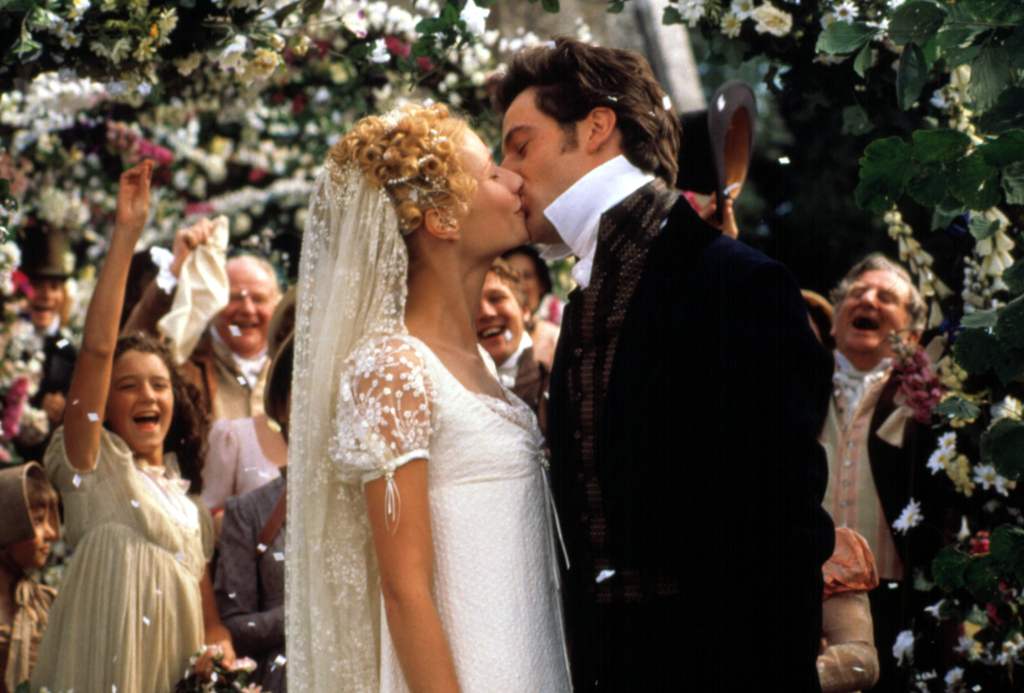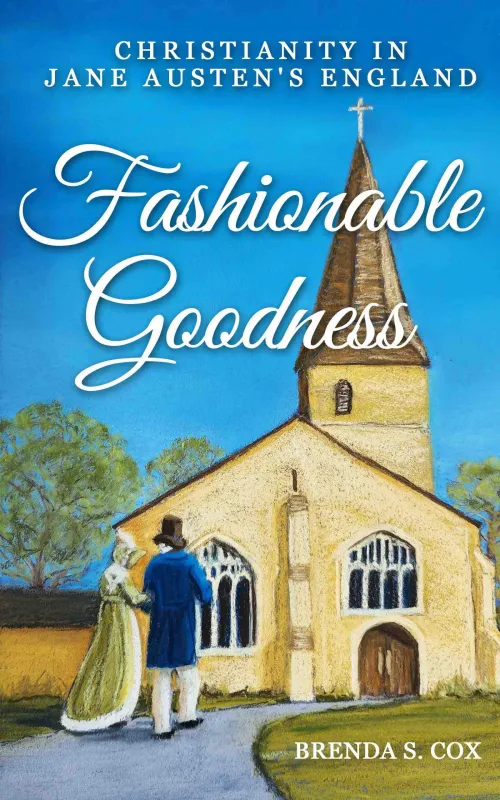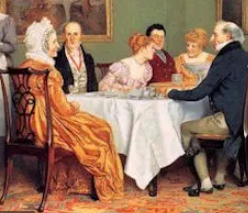By Brenda S. Cox
“ . . . it was settled that they should be married as soon as the Writings could be completed. Mary was very eager for a Special Licence and Mr. Watts talked of Banns. A common Licence was at last agreed on.”—Jane Austen’s Juvenilia, “The Three Sisters”
In Jane Austen’s early story, “The Three Sisters,” Mary is marrying a man she hates, in order to marry before her sisters. She and Mr. Watts argue about everything, with Mary on the side of extravagance and her fiancé on the side of economy. She wants an expensive, exclusive special license (which he would not actually qualify for), while he wants banns, which are free. They agree on a compromise, a common license. What were these three options for getting married?

Dr. Syntax Preaching, from The Tour of Doctor Syntax, 1812. Image Public Domain, from the British Library via Flickr Commons and Wikimedia Commons.
Banns
“The idea of Edward’s being a clergyman, and living in a small parsonage-house, diverted him beyond measure;—and when to that was added the fanciful imagery of Edward reading prayers in a white surplice, and publishing the banns of marriage between John Smith and Mary Brown, he could conceive nothing more ridiculous.” –Robert Ferrars thinking of his brother Edward as a clergyman in Sense and Sensibility
Most people got married with banns; the free option. The couple had to notify the parish clergyman a week in advance of the first announcement. They told him their full names, places of residence, and intention to marry. Then the parson announced the banns three Sundays in a row.
If the couple lived in different parishes, the banns had to be announced in both their parish churches (or chapels, if they attended a chapel-of-ease for a parish church).
Each Sunday, the minister would announce, for example, “I publish the banns of marriage between Charles Bingley of Meryton and Jane Bennet of Meryton. If any of you know cause or just impediment why these two persons should not be joined together in holy matrimony, ye are to declare it. This is the first (or second, or third) time of asking.” (I am assuming that the parish was named after its principal town, Meryton, as parishes often were, and that they lived in the same parish.)
If either of them was under twenty-one, a parent could stand up and say he did not agree to the marriage, and prevent the wedding. If anyone else knew of another objection, such as one of the people being already married, or the couple being too closely related to each other, they could also block the marriage.
Once the banns had been announced three times, with no objections, the parson could perform the marriage. It had to be in the parish church or chapel, between 8 AM and noon.
Everyone except for Quakers and Jews had to be married in the parish church, unless they had a special license. Roman Catholics had to be married by an Anglican clergyman (even with a special license), but could also have their own Catholic ceremony. All marriages had to be registered in the parish church’s registry, wherever they took place.
Those who did not want the publicity of banns, or who were in a hurry to get married (perhaps the bride was pregnant), or who simply wanted the prestige of paying for a license, had two other options.

A clergyman like Mr. Elton could marry a couple by banns, common license, or special license.
Common Licenses
“Upon my word, it is really a pity that it should not take place directly, if we had but a proper licence, for here we are altogether, and nothing in the world could be more snug and pleasant.”—Julia Bertram in Mansfield Park, when they are in the Sotherton chapel, speaking of Mr. Rushworth’s wedding to Maria
Mary and Mr. Watts agree on a common license, which was also called a standard license or a bishop’s license. Julia Betram may also be thinking of a common license, though it would have to have been written specifically for the Sotherton chapel. (That chapel would not necessarily be a place where marriages could take place. If it isn’t, they would need a special license to marry there.)
A bishop or his representative could issue this license, which was much more popular than a special license. It cost two or three pounds. It was valid for three months, and the couple had to wait seven days before getting married. (In many parts of the country, it would take longer than that to go to London, get a special license, and return.)
The common license named the church or chapel for the marriage: normally the parish church of one of them, in a parish where he or she had lived for at least four weeks. They could marry any morning, in that church.
If the bride or groom was under 21, the groom or other witnesses had to swear that they had their parents’ consent and there was no bar to their marriage, or they might need a written statement of approval from the parents. (If they married without their parents’ consent and it was discovered later, the marriage was invalid.)
A rich couple, particularly from the nobility, might have one more option: a special license.

Did they get married by special license, as Mrs. Bennet hoped?
Special Licenses
“My dearest child,” she cried, “I can think of nothing else! Ten thousand a year, and very likely more! ‘Tis as good as a Lord! And a special licence. You must and shall be married by a special licence.” –Mrs. Bennet, Pride and Prejudice, when Elizabeth tells her she is marrying Darcy
Authors of Regency fiction love to have their characters marry by “special license.” The Archbishop of Canterbury, highest church official, could issue special licenses which allowed a couple to get married anywhere at any time. Application had to be made to the ecclesiastical court at Doctors Commons in London.
Such licenses were limited to members of the nobility and their children, baronets (like Sir Walter Elliot) and knights (like Sir William Lucas; these were titled people but not nobility), certain high government officials, and Members of Parliament. Others could get a license if they could convince the Archbishop that they really needed it because of their particular circumstances. Darcy doesn’t exactly fit in these categories, although he is the grandson of an earl so probably has good enough connections to get one if he wants it. He could certainly have paid the five pound fee. (It became five pounds around 1811.)
Special licenses were rare. In 1730, six were issued; in 1830, twenty-two were issued. In contrast, around 2,700 common licenses were issued per year.
Elopements
One more option, of course, was that an underage couple without their parents’ consent could run all the way north to Scotland. There, just across the border at Gretna Green (or anywhere, really), they could be married by anyone–a blacksmith did many such weddings. Scotland had few restrictions on marriage at that time. It wasn’t totally clear how legal such marriages were in England, but they were usually accepted.
Jane Austen makes no other mention of banns or licenses in her novels, so we’re free to imagine how each of her couples got married. Wickham and Lydia probably had a common license, to speed up their marriage. It’s possible, though, that Darcy requested a special license for them because of their circumstances, having lived together already. I imagine Emma and Mr. Knightley upholding English tradition and having banns called in both their parish churches. Although that might have been too much of a trial for Mr. Woodhouse’s nerves (and maybe he would even have objected!), so perhaps they got a common license. For the rest; what do you think?
Note: The British write licence for the noun, while Americans write license. I’ve used licence in the quotes and license elsewhere.
Sources, which also give more details
Nancy Mayer, Regency Researcher, personal correspondence and her excellent website
Many thanks to Nancy for all her help!
Marriage Allegations, Bonds and Licences in England and Wales
Pride and Prejudice, Cambridge Edition of the Works of Jane Austen, edited by Pat Rogers, Cambridge University Press, 2006, notes 538-539.
Hardwicke Marriage Act of 1753, full text
Ecclesiastical Law by Richard Burn, LLD. London: Strahan, 1797. Sixth edition. Volume 3, pages 460-465.
Brenda S. Cox writes on Faith, Science, Joy, and Jane Austen, and is working on a book to be called Fashionable Goodness: Faith in Jane Austen’s England. She will be speaking at the JASNA 2021 AGM on “Satirical Cartoons and Jane Austen’s Church of England.”









While I knew most of this, I appreciate the detail you’ve gone into with the different ways for couples to marry.
denise
This is why your blog is the best source of detail for authors. I can’t tell you how many times I “Google” something and this is the first and best place to find the information. Thank you for all you do, Vic. It’s always enjoyable.
Thank you, Karen. This article was written by Brenda Cox, a most talented researcher and published writer. Along with Rachel Dodge and Tony Grant, I am blessed with great writers. Feel free to contribute an article! Vic
I had never before heard that Roman Catholics were required to be married by an Anglican clergyman in addition to their own Catholic ceremony. For how long did that requirement continue to be enforced?
Very informative! Thank you Brenda. I can understand why a license of some sort might be more convenient in a very few cases, but it sounds like some people just considered them more fashionable, even if they provided no real benefit. Was that the case? Or did some feel that “reading the banns” was a bit vulgar, exposing your future marriage to public scrutiny? It does seem like an interesting bit of democracy that before a nobleman could be married, the local clergyman would formally ask all the common people in church three times whether he was really allowed to. That is, unless the nobleman in question shelled out for a license.
Yes, Ben, I think both of those were possible reasons–fashion and feeling “above” the common crowd.
When Marilyn and I got married in 1985 we had our banns called in Marilyns parish church in Wales by the local Church of Wales vicar and the banns were called also on three consecutive Sundays at my Roman Catholic parish in Southampton. Anybody who didn’t think we should marry for any reason could stand up and give their reason. Well, as you can tell 36 years later Ha! Ha! We had the registrar from the local council at our wedding which took place at Marilyns Welsh parish where we got married. And we had the local vicar doing the religious service. I received permission to get married in a Church of Wales as a Roman Catholic from my diocesan bishop at Portsmouth which Southampton comes under. Our marriage was registered in my parish in Southampton, also at Marilyns church in Wales. It was also registered at the Catholic church in Tenby the nearest catholic church to where were married and also the Catholic church near where we lived at the time in South London. NO ESCAPE !!! According to your above article Brenda we had every base covered and more. This was usual up until recently. I don’t think banns have to be called anymore if you don’t want them. My son Sam who lives in Berlin married his German wife in Edinburgh. They just had to apply for a licence which in Scotland you can get very quickly.. Sam and Sophie married in the registry office on the Royal Mile.They had no banns or religious service. They kept it streamlined!!
Now Brenda, you mustn’t laugh. I made a mistake above. Marilyn will kill me for this. We have been married 39 years as of this moment. Please erase the 36 years. Amnesia setting in here I think Brenda,
Just a thought. I remember when our banns were called each Sunday in two different churches there was always a feeling of tension. I would phone my Mum and Marilyn would phone her Mum.” Did anybody say anything? Is anybody complaining about us?” We always wondered if anybody would actually stand up. Also during the wedding service when the congregation is asked if they know of any impediment. Everybody held their breath. You could cut the atmosphere with a knife. Ha! Ha! It was all a bit of theatre. Everybody I think enjoys all that in a way.
Tony, I absolutely love your personal journey of the banns and the anxious thoughts that you and Marilyn, as a young couple, must have felt waiting for acceptance. Glad the whole business has streamlined these days. Except for heiresses today, who might be absconded to Scotland for a quickie marriage, a la Las Vegas style, I doubt the banns hold as much sway today as they did back then.
Thanks, Tony! I can imagine that would feel very uncomfortable, having the congregation asked every Sunday whether they objected to your getting married! :-) But I can also see that back in Austen’s time, when there was no internet and not much in the way of records shared from one place to another, that it would be useful to check and make sure nobody in either parish knew of a reason why the couple shouldn’t marry. I can imagine someone popping up and saying, wait, that woman was married to my cousin Harry, who got transported to Australia for poaching and as far as we know he’s not dead . . . Things are a lot different today, thankfully.
Excellent and well researched article – a pleasure to read, Brenda!
Thanks to generalgtony for his personal details…it makes it all much realer and more contemporary!
brief etymology thing here; Licence is the noun in British English, but for the verb, we license things. In the same way we have to practise our various practices. Americans opted to have one word for both.
Thank you, very cogently and concisely put.
Yes, Sarah, thanks for confirming what I said at the end about license/licence; and thanks for clarifying that it’s the same with practise/practice. I write so much about Austen’s England that i often get called out by Americans for “misspelling” words, when I’m actually using the British spelling. It’s tricky!
and then if writing anything period with a mystery one should properly have a ‘clew’ not a ‘clue’ being the end of a thread á la Ariadne; and someone pragmatic was a busybody, and my favourite bugbear of modern Regency authors ‘feisty’ a word in period being slang and meaning ‘flatulent’ and normally used for small dogs; call your heroine feisty and you are saying she’s a real bitch with gas problems. [cf Feste the Jester in Shakespeare, referencing that aspect of the rather broad humour of jesters of the time, which is the origin]. Language is living, but Oh! that pond which separates and its differences…took me a while to recognise that being told I looked puny meant that I was looking unwell, not that I was a total wimp.
Marilyn doesn’t mind. My memory went a bit wonky. All the best, Tony
I’m checking in here after a long time away, and grateful as always for all the historical details. I have only one minor quibble: I think that in P&P, the small village of Longbourn has its own church and its own parish priest–so that the Bingley/Bennet banns would have mentioned “Charles Bingley of Meryton and Jane Bennet of Longbourn.” JA refers to Longbourn in Vol.1, Ch. 3 as “the village where [the Bennets] lived, and of which they were the principal inhabitants.” And Mr. Collins says in his letter in Vol. 3, Ch. 15, re: the Wickhams’ nuptial visit to Longbourn, that “had I been the rector of Longbourn, I should very strenuously have opposed it.” I don’t know about you, but I’m not going to argue with Mr. Collins.
And I do hope that General Tony has worked things out with his Marilyn by now…
Great catch, A. Marie! Collins does say “the rector of Longbourn,” which presumably means Longbourn was its own parish. I don’t think we know what parish Netherfield was in, though.
Sarah, puny, actually means tiny and weak. If somebody said that to you, they weren’t being rude they probably meant that they thought you needed feeding up. They were being caring and were concerned for you. Tony
The , general, bit is an old school nickname I attach to my e-mail address. A teacher I had when I was teenager was a French Canadian and insisted on calling me General after Ulysses S Grant., my surname being Grant. All my school friends took to calling me The General. I also played centre defender in the school football (soccer) team. Being called ,The General, fitted with my role of taking charge of the defence.
Thanks for that explanation, Tony! I was curious but didn’t want to ask. :-)
A really fascinating look on the behind the scene details of a marriage in regency england! Thank you for the article it really is easy to read through and detailed
You’re welcome, Maria! It was fun to write!